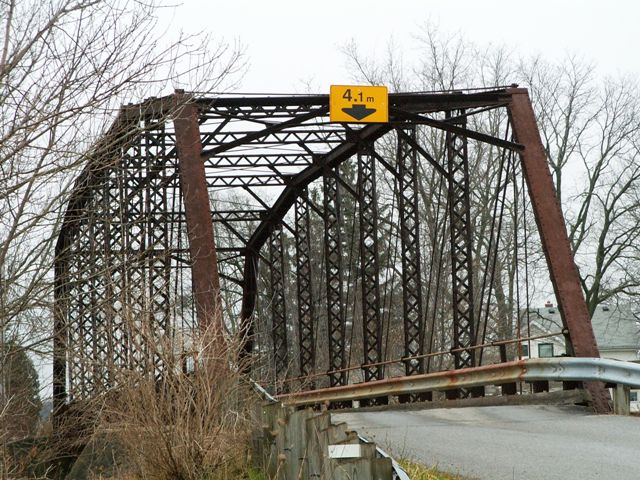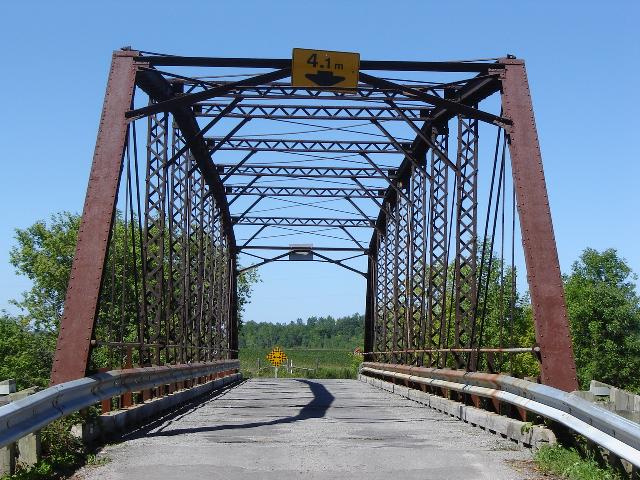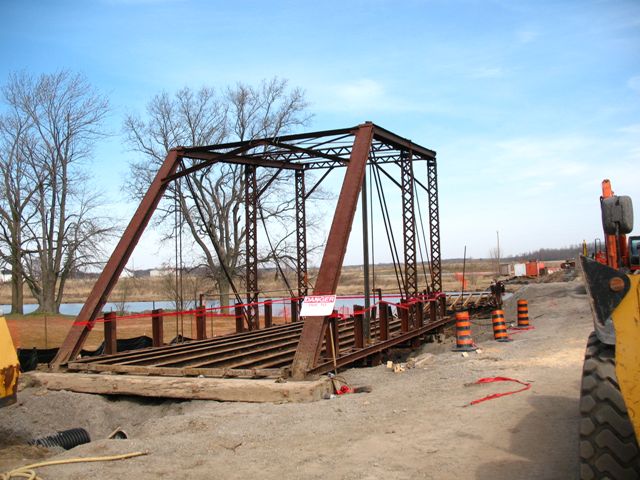We Recommend:
Bach Steel - Experts at historic truss bridge restoration.
O'Reilly's Bridge

Primary Photographer(s): Nathan Holth
Bridge Documented: 2005 and 2007
Rural: Niagara Region, Ontario: Canada
Not Available or Not Applicable
Not Available
Not Available
Not Available
1 Main Span(s)
Not Applicable

View Information About HSR Ratings
Bridge Documentation
This bridge no longer exists!
This extremely rare heritage bridge was demolished by Niagara Region in April 2010!
About This Bridge
This magnificent bridge was an extremely rare example of a pin connected camelback truss bridge in Ontario. Camelback truss bridges are a variation of the Parker truss, where the camelback has exactly five slopes contained in the top chord and end post. A Parker truss Parker truss is essentially a Pratt truss with a polygonal top chord.
At the time this narrative was composed, HistoricBridges.org had 1205 truss bridges documented in the United States and Canada combined. Of those, only 18 were pin-connected Camelback truss bridges, or 1.5% of all truss bridges. At that time, only one other pin-connected Camelback truss had been documented by HistoricBridges.org in Ontario and it was a railroad bridge. This indicates that O'Reilly's Bridge was an exceedingly rare structure in Ontario, and a rare structure in both the United States and Canada.
The portal bracing on the bridge was an a-frame design. V-lacing was present on built-up vertical members and on the struts. Modern Armco style railings are present on the bridge, although pole railings also were present on the bridge. Although this bridge originally may have had pole railings, the actual poles present on the bridge looked newer than the rest of the bridge, suggesting they were replaced. The bridge was nine panels in length. The bridge sat on concrete abutments, which showed some signs of deterioration but are in otherwise fair condition. The deck was wooden with an asphalt wearing surface on top. The asphalt had worn off quite a bit. No plaques survived on the bridge. The bridge was posted at a 4.1 meter vertical clearance. The structure appeared to be in decent condition, despite a lack of paint and a presence of rust on the bridge. A major modification was made to this bridge when some of the diagonal members were replaced with steel cables, and the floorbeams appear to have been replaced as well. Needless to say, these modifications affected the historic integrity of the bridge. However, significant original bridge material remained including vertical members, top chord, end post, and struts. Also, the general aesthetic qualities this bridge enjoyed were not affected much by the alterations. Further, the bridge retained the key elements of significance, those being the pin connections and the five sloped camelback design of the top chord and end posts. Given the exceedingly rare design of the bridge especially in Ontario, these alterations did not diminish the significance of the bridge and its heritage value.
Events Prior To The Demolition Project

This bridge had a few years before demolition been lowered to a two tonne weight limit due to concerns about the tension hangers of the bridge, according to a Welland Tribune article. Emergency repairs to the bridge were made, and raised the weight limit up to six tonnes, but were still down from the previous 15 tonne weight limit present on the bridge. This brought the future of the bridge into discussion. One option, which was unpleasant and not needed, was to tear the bridge down and build a new one. The other options that were more appealing and appropriate were to restore the existing bridge's substructure to get it back to the 15 tonne weight limit, for a fraction of the cost of a total replacement. Another option was to build a new bridge at a different alignment which may have also been appropriate. If this occurred, the news article mentioned that the truss bridge would likely remain and become a pedestrian crossing, so this should have been considered a preservation alternative.
Later, Niagara Region decided to ignore the numerous opportunities for preserving this heritage bridge and they moved to demolish and replace the bridge with an ugly slab of concrete.
In 2009, the bridge was closed to all traffic.
In April 2010, the demolition project began.

Above: An interpretive kiosk is all that remains of this bridge. Photo Credit: Ed Blasinski
Flawed Transportation Policies: A North American Problem
Any bridge historian who crosses the border from the United States into Canada hopes that they leave behind the flawed transportation policies, close-minded highway agencies, and outright ignorance that has led to the needless demolition of countless bridges with heritage value in the United States. Sadly however, this is not the case upon entering the province of Ontario. It is unclear whether Ontario has simply made the foolish decision to look to the United States as a role model for surface transportation policy, or whether Ontario's surface transportation policies have devolved into a flawed system of its own accord. What is striking however is the similarities between the United States and Ontario. Even the actual processes are nearly identical. For instance, both the United States and Ontario conduct an Environmental Assessment prior to a bridge replacement project. Both assessments include a look at alternatives to demolition and replacement. Just like the United States however, Ontario also appears to consider these alternatives as simple red tape to be cut through as quickly as possible, and they do not appear to seriously consider any alternatives to demolition.
![]()
Photo Galleries and Videos: O'Reilly's Bridge
2007 Bridge Photo-Documentation
Original / Full Size PhotosA collection of overview and detail photos, taken in early 2007. This gallery offers photos in the highest available resolution and file size in a touch-friendly popup viewer.
Alternatively, Browse Without Using Viewer
![]()
2007 Bridge Photo-Documentation
Mobile Optimized PhotosA collection of overview and detail photos, taken in early 2007. This gallery features data-friendly, fast-loading photos in a touch-friendly popup viewer.
Alternatively, Browse Without Using Viewer
![]()
2005 Bridge Photo-Documentation
A collection of overview and detail photos, taken August 24, 2005. This photo gallery contains a combination of Original Size photos and Mobile Optimized photos in a touch-friendly popup viewer.Alternatively, Browse Without Using Viewer
![]()
2010 Bridge Demolition
Original / Full Size PhotosDemolition of this heritage bridge. This gallery offers photos in the highest available resolution and file size in a touch-friendly popup viewer.
Alternatively, Browse Without Using Viewer
![]()
2010 Bridge Demolition
Mobile Optimized PhotosDemolition of this heritage bridge. This gallery features data-friendly, fast-loading photos in a touch-friendly popup viewer.
Alternatively, Browse Without Using Viewer
![]()
2021 Replacement and Interpretive Kiosk
Original / Full Size PhotosA supplemental collection of photos that are from additional visit(s) to the bridge and have not been organized or captioned. This gallery offers photos in the highest available resolution and file size in a touch-friendly popup viewer.
Alternatively, Browse Without Using Viewer
![]()
2021 Replacement and Interpretive Kiosk
Mobile Optimized PhotosA supplemental collection of photos that are from additional visit(s) to the bridge and have not been organized or captioned. This gallery features data-friendly, fast-loading photos in a touch-friendly popup viewer.
Alternatively, Browse Without Using Viewer
![]()
Maps and Links: O'Reilly's Bridge
This historic bridge has been demolished. This map is shown for reference purposes only.
Coordinates (Latitude, Longitude):
Search For Additional Bridge Listings:
Additional Maps:
Google Streetview (If Available)
GeoHack (Additional Links and Coordinates)
Apple Maps (Via DuckDuckGo Search)
Apple Maps (Apple devices only)
Android: Open Location In Your Map or GPS App
Flickr Gallery (Find Nearby Photos)
Wikimedia Commons (Find Nearby Photos)
Directions Via Sygic For Android
Directions Via Sygic For iOS and Android Dolphin Browser




